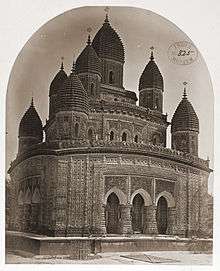Navaratna (architecture)

A southern view of Kantajew Temple in Dinajpur, Bangladesh, as it was in 1871, with seven of the nine spires visible, of the navaratna architecture that were subsequently destroyed in an earthquake
The navaratna style of temple architecture (Sanskrit: नवरत्न, meaning "nine gems") incorporates two main levels, each with four spired corner pavilions, and a central pavilion above, for a total of nine spires. The style arose in Bengal during the eighteenth century as an elaboration of the pancharatna style that had five pavilions (four at the corners and one above).[1]
Examples
This type of temples are very common. Some notable temples are [2]
- Kantajew Temple, Dinajpur
- Hati-Kumrul temple, Pabna
- Dhamrely temple, Khulna
See also
References
| Wikimedia Commons has media related to Navaratna temples. |
- ↑ Ghosh, P. (2005). Temple To Love: Architecture And Devotion In Seventeenth-Century Bengal. Indiana University Press. ISBN 9780253344878.
- ↑ http://en.banglapedia.org/index.php?title=Temple_Architecture
This article is issued from
Wikipedia.
The text is licensed under Creative Commons - Attribution - Sharealike.
Additional terms may apply for the media files.